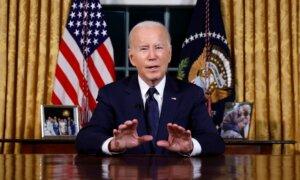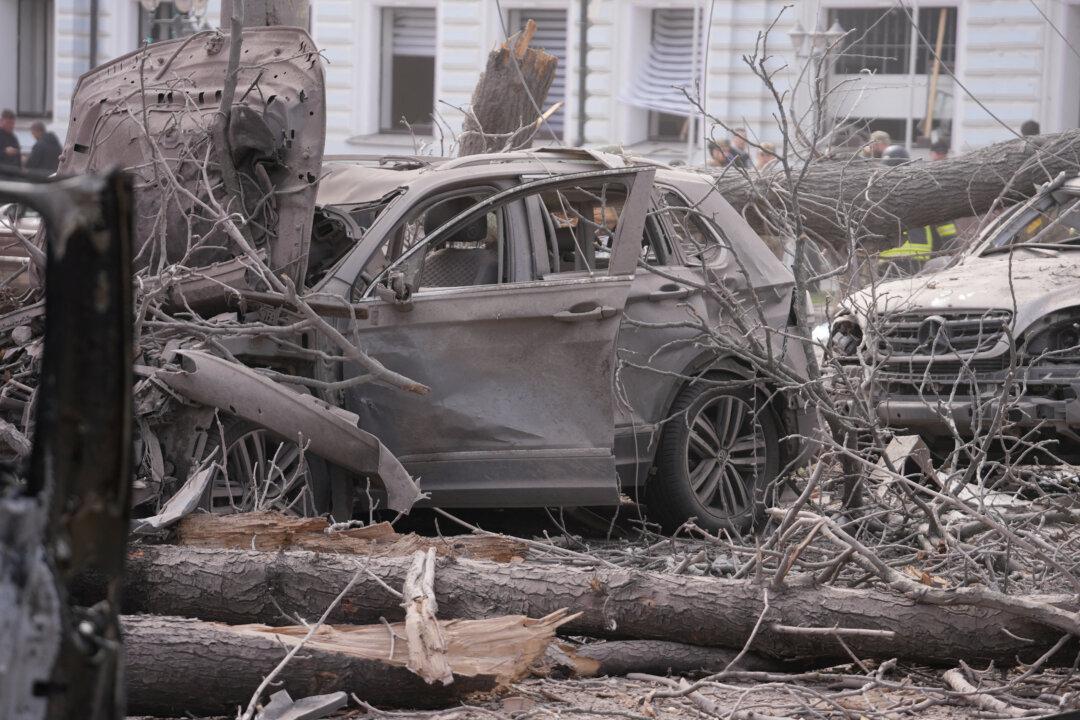As Israel gears up to invade the besieged Gaza Strip, military officials have voiced fears of a possible “third front” opening up in the next-door West Bank.
Speaking to Reuters on Oct. 20, Jonathan Conricus, an army spokesman, said Gaza-based terrorist group Hamas sought to “engulf” Israel in a “two- or three-front war.”
“The threat is elevated,” the spokesman said.
Home to some 2.75 million Palestinians and 670,000 Jewish settlers, the West Bank also includes Israeli-controlled East Jerusalem—long a flashpoint for violence between the two sides.
Israeli fears of a “third front” emanating from the West Bank coincide with an ongoing Israeli air campaign against the Hamas-run Gaza Strip.
For the past 13 days, Israeli warplanes have pounded the coastal enclave, leveling buildings and killing hundreds—maybe thousands—of Palestinians.
The airstrikes come in response to a deadly cross-border raid by Hamas terrorists on Oct. 7, which left some 1,400 Israelis—soldiers and civilians—dead.
During the attack, Hamas gunmen also took scores of Israelis hostage, hoping to exchange them for Palestinian prisoners.
On Oct. 20, Israeli Defense Minister Yoav Gallant said Israel’s ongoing war on Gaza was aimed at “eliminating” Hamas and creating a new “security framework.”
On the same day, Gaza’s health ministry claimed more than 4,000 Palestinians had so far been killed—and 13,000 injured—in round-the-clock Israeli airstrikes.
Israel has also vowed to launch a ground invasion of the Gaza Strip, around which it has amassed hundreds of troops, along with tanks and other offensive equipment.
Until now, however, it remains unclear when—or if—Israel will launch its promised ground invasion.
On Oct. 19, Mr. Gallant said that Israeli troops amassed along the enclave’s border would soon see the Hamas-run Gaza Strip “from inside.”
Since 2007, the Gaza Strip has been subject to a blockade by Israel and Egypt, the latter of which shares a 7.5-mile border with the Palestinian territory.

Hezbollah: Israel’s ‘2nd Front’
Since the latest round of Mideast violence began, Israel has also traded blows with Lebanon’s Shiite Hezbollah militia, with which it continues to exchange cross-border artillery fire.Both sides claim to have taken casualties, including Israeli troops and Hezbollah fighters, in addition to Israeli and Lebanese civilians.
Amid tit-for-tat artillery exchanges, Israel on Oct. 20 said it planned to evacuate 20,000 residents of Israel’s northern town of Kiryat Shmona.
According to an Israeli army spokesman, the large-scale evacuation is meant to provide Israel’s military with greater “operational freedom” against Hezbollah.
Hezbollah, with which Israel fought a bloody month-long war in 2006, is closely aligned with Iran—long seen as the Jewish state’s arch-foe in the region.
In an Oct. 20 statement, Hezbollah warned that “the killing of Lebanese civilians and assaults on our country’s security [by Israel] will not go unanswered.”
During a visit last week to Beirut, Hossein Amir-Abdollahian, Iran’s foreign minister, warned that Israeli “war crimes” against Gaza’s Palestinians would draw a response from the “axis of resistance.”
The geopolitical term refers to a loose alliance of regional states and groups vehemently opposed to Israel.
Along with Iran, the “axis of resistance” includes Syria, Hezbollah, and Gaza-based terrorist groups Hamas and Islamic Jihad.
During his trip to the Lebanese capital, Mr. Amir-Abdollahian also met with longtime Hezbollah leader, Hassan Nasrallah.
Tehran has praised Hamas’s cross-border raid into Israel while rejecting Israeli and Western claims that it played a significant role in the deadly attack.

West Bank at Boiling Point
Violence has also engulfed the Israeli-controlled West Bank, a separate landlocked Palestinian enclave partially run (along with Israel) by the Ramallah-based Palestinian Authority (PA).Since the latest violence erupted on Oct. 7, more than 80 West Bank Palestinians have been killed in clashes with Israeli troops and armed Jewish settlers, Reuters reported on Oct. 20.
Over the same period, 900 West Bank Palestinians were detained by Israeli security forces, according to the news agency.
Scores more were reportedly rounded up in overnight Israeli raids in the early hours of Oct. 20.
According to Israel’s military, at least one Israeli officer was killed while taking part in the pre-dawn raids.
One day earlier, Israeli warplanes reportedly struck a refugee camp in the West Bank, killing 12 Palestinians, PA officials said.
The Epoch Times could not independently verify claims made by either side.
Along with the 16-year Gaza blockade, Hamas has cited heavy-handed Israeli policies in the West Bank as a reason for its deadly cross-border rampage.
Since an Oct. 17 blast at a Gaza hospital that reportedly left hundreds of Palestinians dead, angry protests have erupted sporadically across the West Bank.
Israel and the Palestinians have traded blame for the hospital blast, which, according to Gaza’s health ministry, killed more than 450 Palestinians.
In Ramallah, Palestinians have demanded the resignation of PA President Mahmoud Abbas, who they say has not done enough to stop Israel’s onslaught on Gaza.
While Mr. Abbas has condemned Israel’s war on the coastal enclave, his security forces have also cracked down on Palestinian protests in the West Bank.
On Oct. 18, Mr. Abbas canceled a planned four-way meeting with U.S. President Joe Biden, who arrived in the region to voice his full-throated support for Israel.
Mr. Abbas was joined by the leaders of Egypt and Jordan—both longstanding U.S. regional allies—in refusing to meet with President Biden.
In 1967, Israel captured the Gaza Strip from Egypt and the West Bank from neighboring Jordan.
In 2005, Israeli forces withdrew from the former, while the West Bank remained under Israeli control.
In 2007, Hamas wrested control of the Gaza Strip from rival Palestinian faction Fatah, which is currently headed by Mr. Abbas.
Despite the two factions’ longstanding rivalry, Mowafaq Sehweel, a Ramallah-based Fatah leader, told Reuters on Oct. 20: “We should let go the reins and use any means to fight [Israel’s] occupation.”







